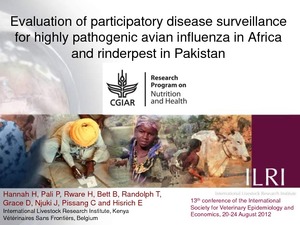Evaluation of participatory disease surveillance for highly pathogenic avian influenza in Africa and rinderpest in Pakistan
Abstract
Participatory disease surveillance (PDS) has been promoted in developing countries to complement
conventional surveillance, particularly for rinderpest eradication and Highly Pathogenic Avian Influenza
(HPAI) control. We conducted an evaluation participatory epidemiology (PE) and PDS capacity building
outcomes by examining PDS as a surveillance tool for national animal disease surveillance. The evaluation
framework pillars (relevance, effectiveness, efficiency, sustainability and impact) were developed from over
30 indicators adapted from established animal and public health surveillance criteria together with additional
measures of sustainability and participation. Data were collected from 120 individuals by workshops,
questionnaires and semi-structured interviews in Benin, Nigeria, Pakistan, Tanzania, Togo and Uganda.
PDS results were consistent with other data for absence of disease but the absence of detected cases and a
dearth of epidemiological and surveillance data prevented quantification of some indicators. In contexts of
limited epidemiological capacity, PDS was considered a useful epidemiological tool, most appropriate for
small-scale farmers and applied in complement to conventional surveillance. PDS generated large amounts
of unanalyzed data which were incompatible with conventional databases. The approach did not alter the
one-way information flow characteristic of surveillance systems. PE skills continued to be used by some
individual practitioners but PDS sustainability was compromised by dependence on external funding, the
lack of legal frameworks and failure to integrate into national surveillance systems. In extracting surveillance
information from communities, PDS was inconsistent with empowerment and ownership espoused by
participatory learning and action approaches. Stakeholders had a positive attitude towards PDS despite the
limited evidence for impact or cost effectiveness.

